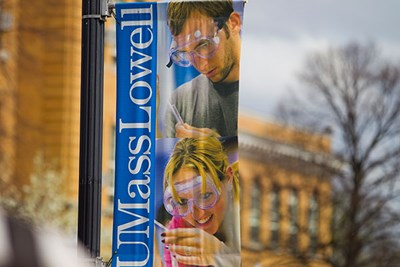Apr 2 2020
A research team, headed by nuclear physicists at the University of Massachusetts Lowell (UMass Lowell), has made a discovery that might redefine the way atoms are interpreted by researchers and might help to describe the extreme phenomena occurring in outer space.
 A UMass Lowell-led team of nuclear physicists has discovered the symmetry that exists within the core of atoms is not as fundamental as scientists have believed. Image Credit: University of Massachusetts Lowell.
A UMass Lowell-led team of nuclear physicists has discovered the symmetry that exists within the core of atoms is not as fundamental as scientists have believed. Image Credit: University of Massachusetts Lowell.
This latest breakthrough made by the scientists demonstrated that a symmetry existing inside the atom’s core is not as fundamental as researchers have assumed. This crucial finding explains the operating forces inside the atoms’ nucleus, paving the way to a deeper understanding of the universe. The study results have been published in one of the world’s leading scientific journals, Nature.
This recent discovery was made when the research team headed by UMass Lowell was exploring ways to establish the generation of atomic nuclei in X-ray bursts—that is, explosions that occur on the neutron stars’ surface. Neutron stars are the remains of giant stars at the last phase of their life.
We are studying what happens inside the nuclei of these atoms to better understand these cosmic phenomena and, ultimately, to answer one of the biggest questions in science, how the chemical elements are created in the universe.
Andrew Rogers, Study Lead and Assistant Professor, Department of Physics, University of Massachusetts Lowell
The U.S. Department of Energy has granted $1.2 million to UMass Lowell for the study, which was carried out at the National Superconducting Cyclotron Laboratory (NSCL) at Michigan State University.
Researchers at the laboratory generate unusual atomic nuclei to quantify their characteristics so as to interpret their role as the building blocks of the cosmos, of matter, and of life itself.
Atoms can be described as the smallest units of matter. Every atom contains electrons that revolve around a minute nucleus deep inside its core, which includes all its energy and mass.
Two almost identical particles—uncharged neutrons and charged protons—are present in atomic nuclei. The number of protons present in a nucleus decides the type of element the atom belongs to in the periodic table and, consequently, its chemistry. While isotopes of an element have the same number of protons, they contain a different number of neutrons.
At the NSCL, nuclei were expedited almost at the speed of light and broken down into fragments that form strontium-73. Strontium-73 is a rare isotope that does not occur naturally on Earth but can occur for brief periods of time during powerful bursts of thermonuclear X-rays on the neutron stars’ surface. Containing 35 neutrons and 38 protons, this isotope of strontium exists just for a fraction of a second.
The researchers worked round the clock for eight days and eventually developed over 400 strontium-73 nuclei. They subsequently compared the strontium-73 nuclei to the recognized properties of bromine-73—an isotope containing 38 neutrons and 35 protons. With an interchanged number of neutrons and protons, the nuclei of bromine-73 are believed to be “mirror partners” to the nuclei of strontium-73.
The presence of mirror symmetry in nuclei can be attributed to the similarities between neutrons and protons and underscores researchers’ interpretation of nuclear physics.
The scientists produced one strontium-73 nucleus about every half-hour, then delivered it through the isotope separator of NSCL, and later brought the nucleus to a stop at the core of a complex detector array, where they could examine its behavior.
By analyzing the radioactive decay of such nuclei, the researchers discovered that the behavior of strontium-73 was completely different from that of bromine-73. According to Rogers, this finding raises some new, significant questions relating to nuclear forces.
Strontium-73 and bromine-73 should appear identical in structure, but surprisingly do not, we found. Probing symmetries that exist in nature is a very powerful tool for physicists. When symmetries break down, that tells us something’s wrong in our understanding, and we need to take a closer look.
Andrew Rogers, Study Lead and Assistant Professor, Department of Physics, University of Massachusetts Lowell
According to Daniel Hoff, a research associate at UMass Lowell, the phenomena observed by the researchers will challenge nuclear theory. Hoff is also the lead author of the study published in the Nature journal.
Comparing strontium-73 and bromine-73 nuclei was like looking in a mirror and not recognizing yourself. Once we convinced ourselves that what we were seeing was real, we were very excited.
Daniel Hoff, Study Lead Author and Research Associate, University of Massachusetts Lowell
In addition to Rogers, a resident of Somerville, and Hoff, who lives in Medford, the research team at UMass Lowell included Physics Department faculty members Assistant Professor Peter Bender; Professor Emeritus C.J. Lister; and former research associate of UMass Lowell Chris Morse.
The study also included physics graduate students Emery Doucet of Mason, N.H., and Sanjanee Waniganeththi of Lowell.
As part of the study performed by the researchers, sophisticated theoretical calculations were performed by Simin Wang, a research associate at Michigan State, and guided by Witold Nazarewicz, the John A. Hannah Distinguished Professor of Physics from MSU and also a chief scientist at the Facility for Rare Isotope Beams (FRIB), which will open the subsequent year.
The scientists’ work “offers unique insights into the structure of rare isotopes,” stated Nazarewicz. “But much still remains to be done. New facilities coming online, such as FRIB at MSU, will provide missing clues into a deeper understanding of the mirror symmetry puzzle. I am glad that the exotic beams delivered by our facility, unique instrumentation and theoretical calculations could contribute to this magnificent work.”
Plans for additional experiments are already ongoing, as the scientists look to improve and validate their observations, and further analyze these isotopes.